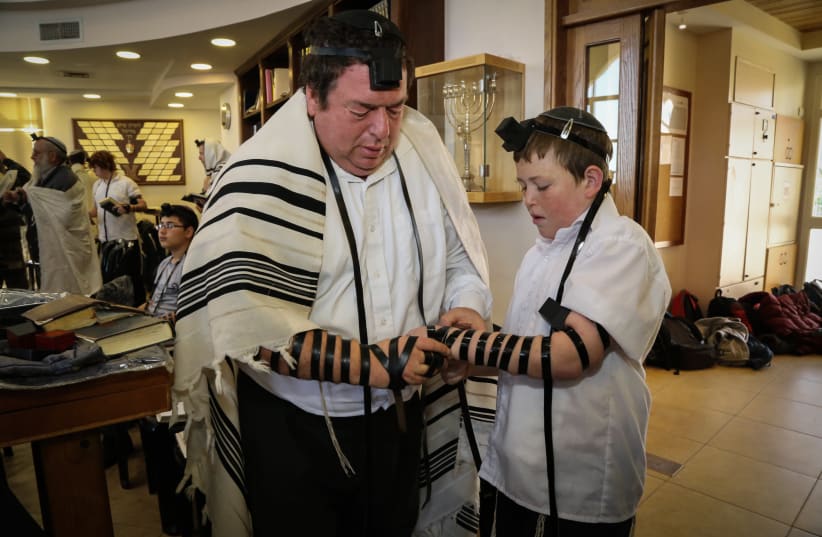Recently, a faithful reader reached out to ask what happened to part two of my series on women’s obligation in mitzvot. To my chagrin, I realized that I never published a part two, so this week will be an opportunity to redress that wrong.
One of the major distinctions between the genders is women’s exemption from positive time-bound mitzvot. Growing up in the Orthodox world, this is often presented definitively as the seminal proof that men and women are intended by God to fulfill different roles. I would go so far as to suggest that the foundation of gender separation rests greatly on this distinction. Examples of time-bound mitzvot are tzitzit, tefillin, sukkah, lulav and shofar. As will be explained in a later column, the concept of “time-bound” defies a uniform designation that complicates the attempt to neatly explain women’s exemption from this category of mitzvot.
There are two reasons that have emerged in modernity as the usual explanations for this gender division:
1. Women are more spiritual than men and as a result “need” less mitzvot to protect themselves. This is understood to be the innate wisdom of Torah, which recognizes that men and women cannot be religiously fulfilled in the same way. Men are at greater spiritual risk and thus require more structure and boundaries to pursue a covenantal relationship with God.
2. Women must take care of their young children, and therefore cannot possibly be obligated in time-bound mitzvot.
According to either approach, there is no nefarious hierarchy that privileges men over women. Women and men are in essence equal in the eyes of God; they simply have different roles to play in religious society. This line of thinking then, interprets the rationale behind the blessing men say daily – “Blessed are You, God, who has not made me a woman” – in a like manner. Men are thanking God for the extra mitzvot bestowed upon them. This should not be perceived as condescending to women’s status. In stark contrast, however, women do not make a blessing thanking God for not making them a man, but rather a generic blessing in which they thank God for making “me as He desired.”
Text study chips away at the edifice presented above in asserting that women are different but equal or, actually privileged by having less mitzvot. First of all, the Torah does not make any such clear distinction. Second, nowhere in the Talmud is any justification put forth for the exemptions of women from a complete category of mitzvot. The primary source for women’s exemption from time-bound mitzvot is in a Mishna in Kiddushin 1:7:
“All of the mitzvot that a father is commanded to do for his son, women are exempted from. And all of the mitzvot the son is commanded to do for the father, both women and men are equally obligated. And all of the positive time-bound commandments, men are obligated and women are exempt. And all of the positive non-time-bound commandments, both women and men are obligated. And all of the negative commandments, whether time-bound or not, both men and women are obligated.”
THERE ARE four categories of mitzvot presented: positive time-bound, positive non-time-bound, negative time-bound and negative non-time-bound. Women are obligated in three of the categories and exempted from mitzvot defined as positive time-bound. No explanation is given and there is no clarity as to what time-bound means or how to define the concept of time in this regard.
Furthermore, the distinction between time-bound and non-time-bound mitzvot appears only when distinguishing the differences between men and women. It serves no other function in the Talmudic discourse. One plausible explanation might be that women were thought to have more of an active duty to husband than to God, although this is not stated explicitly regarding the mitzvah discrepancy. However, it is brought as to explain women’s inability to honor her parents while married. In the words of the Talmud, “The woman is unable to do so [practice honoring her parents] for the authority of others [her husband] is upon her.”
While men and women are equally obligated in the fifth commandment to honor one’s parents, married women are not free to fulfill this obligation because they require permission from their husbands in order to do so. Due to the marital relationship, Halacha (Jewish law) releases them (although they are not exempt) without even citing biblical verses to justify such a move. The message is clear: A married woman will not be free to perform this mitzvah in the same way as a man. In the Middle Ages, this will become a more broadly used justification for why women overall are exempted from positive time-bound mitzvot.
It is noteworthy that both the Jerusalem Talmud and the Babylonian Talmud add a caveat that if a woman becomes widowed or divorced, she resumes her full obligation to her parents, reverting back to the original mitzvah. The exemption is only for the duration of marriage. Furthermore, a husband can certainly allow his wife to fulfil the mitzvah. Already in the 17th century, the prominent commentary on the Shulhan Aruch known as the Shach (Shabtai Ben Meir HaCohen) insightfully noted that if a husband is not insistent that she give up her obligation, a married woman remains fully duty-bound to honor her parents.
In the modern era, it is largely assumed by both husband and wife that a woman will continue to actively honor and respect her parents for the duration of her marriage. In contrast, women’s exemption from time-bound mitzvot is not tied to marital status but to gender and thus there is no time in her life when she is obligated in the mitzvot that appear on this list.
We will continue in the next column with a closer look at how time-bound mitzvot are defined.
The writer teaches contemporary Halacha at the Matan Advanced Talmud Institute. She also teaches Talmud at Pardes along with courses on Sexuality and Sanctity in the Jewish tradition.
